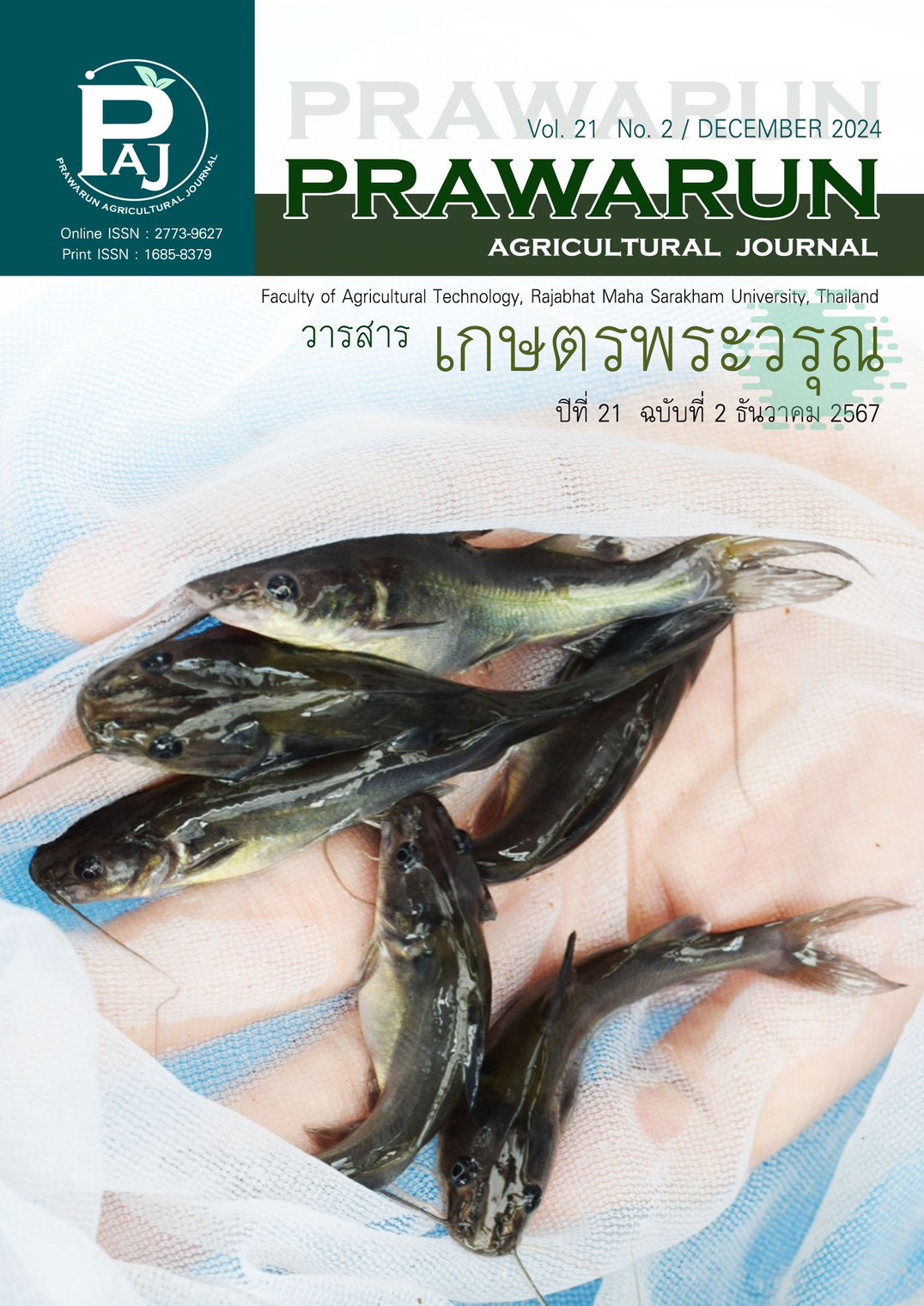ผลการใช้วัตถุดิบแหล่งโปรตีนทางเลือกทดแทนกากถั่วเหลืองบางส่วนในอาหารไก่ไข่
Main Article Content
บทคัดย่อ
ปัจจุบันวัตถุดิบแหล่งโปรตีนอาหารสัตว์มีราคาสูงขึ้นอย่างต่อเนื่อง หากสามารถใช้วัตถุดิบที่มีราคาถูกทดแทนโดยไม่กระทบต่อการให้ผลผลิตและคุณภาพของไข่ไก่อาจทำให้ผู้เลี้ยงไก่ไข่มีทางเลือกเพิ่มขึ้น งานวิจัยนี้จึงมุ่งศึกษาผลของแหล่งโปรตีนทางเลือกต่อการให้ผลผลิตและคุณภาพไข่ไก่ วางแผนการทดลองแบบสุ่มสมบูรณ์ ใช้ไก่ไข่สายพันธุ์ไฮไลน์บราวน์ (Hy-Line Brown) อายุ 23 สัปดาห์ จำนวน 120 ตัว แบ่งออกเป็น 4 กลุ่ม ๆ ละ 3 ซ้ำ ๆ ละ 10 ตัว สุ่มไก่ให้ได้รับอาหารทดลองที่มีแหล่งโปรตีนทางเลือกที่แตกต่างกันทดแทนกากถั่วเหลืองบางส่วนในสูตรอาหาร ได้แก่ กากถั่วเหลือง (กลุ่มควบคุม, T1) เศษปลาหมักกากมันสำปะหลัง (T2) ใบหม่อน (T3) และ ใบกระถิน (T4) ตามลำดับ ให้อาหารและน้ำดื่มอย่างเต็มที่ตลอดการทดลองเป็นระยะเวลา 60 วัน ผลการทดลองพบว่าแหล่งของโปรตีนมีผลต่อค่าปริมาณอาหารที่กินได้ การเปลี่ยนอาหารเป็นน้ำหนักไข่ 1 กิโลกรัม (FCR) ผลผลิตไข่ น้ำหนักไข่ น้ำหนักเปลือกไข่ และค่าคะแนนสีไข่แดงอย่างมีนัยสำคัญทางสถิติ (P < 0.05) โดย T1 มีการกินอาหารสูงสุด (118.89 กรัม/ตัว/วัน) ในขณะที่ T4 มีการกินอาหารน้อยที่สุด (104.74 กรัม/ตัว/วัน) FCR มีค่าต่ำที่สุดใน T1 (2.97) และมีค่าสูงที่สุดใน T2 (3.57) ผลผลิตไข่สูงสุดพบใน T1 (70 เปอร์เซ็นต์) ในขณะที่ T2 มีการผลิตไข่น้อยที่สุด (53.36 เปอร์เซ็นต์) T1 และ T4 มีน้ำหนักไข่มากกว่า T2 และ T3 ส่วน T1 และ T3 มีน้ำหนักเปลือกไข่มากกว่า T4 และ T2 ในขณะที่ T4 มีสีของไข่แดงเข้มที่สุด (7.05 คะแนน) และ T1 มีสีไข่แดงอ่อนที่สุด (4.61 คะแนน) ส่วนความหนาเปลือกไข่ ค่าฮอกยูนิต น้ำหนักไข่แดง และน้ำหนักไข่ขาว มีผลไม่แตกต่างกันทางสถิติ (P > 0.05) สรุปได้ว่า แหล่งโปรตีนทางเลือกจากใบกระถิน (T4) สามารถนำมาใช้ทดแทนกากถั่วเหลืองบางส่วนในสูตรอาหารไก่ไข่ ซึ่งสามารถช่วยให้น้ำหนักไข่ดีขึ้นและช่วยเพิ่มสีของไข่แดงให้เข้มขึ้นได้ แต่อาจส่งผลต่อการกินอาหาร ประสิทธิภาพการเปลี่ยนอาหารเป็นน้ำหนักไข่ และการให้ผลิตไข่
Article Details
เอกสารอ้างอิง
Abu, E. S. (2019). Review on the role of enzyme supplementation on egg production performance of layer. International Journal of Animal Husbandry and Veterinary Science, 4(5), 25-36.
Abou-Elezz, F. M. K., Sarmiento-Franco, L., Santos-Ricalde, R., & Solorio-Sanchez, F. (2011). Nutritional effects of dietary inclusion of Leucaena leucocephala and Moringa oleifera leaf meal on Rhode Island Red hens’performance. Cuban Journal of Agricultural Science, 45(2), 163-169.
Al-Kirshi, R., Alimon, A., Zulkifli, I., Atefeh, S., Zahari, M. W., & Ivan, M. (2013). Nutrient digestibility of mulberry leaves (Morus alba). Italian Journal of Animal Science, 12(2). doi: 10.4081/ijas.2013.e36
Batiha, G. E. S., Al-Snafi, A. E., Thuwaini, M. M., Teibo, J. O., Shaheen, H. M., Akomolafe, A. P., Teibo, T. K. A., Al-Kuraishy, H. M., Al-Garbeeb, A. I., Alexiou, A., & Papadakis, M. (2023). Morus alba: a comprehensive phytochemical and pharmacological review. Naunyn Schmiedeberg’s Archives of Pharmacology, 396(7), 1399–1413. doi: 10.1007/s00210-023-02434-4
De Angelis, A., Gasco, L., Parisi, G., & Danieli, P. P. (2021). A multipurpose leguminous plant for the mediterranean countries: Leucaena leucocephala as an alternative protein source: a review. Animals, 11(8), 2230. doi: 10.3390/ani11082230
Espinosa, C. D., Oliveira, M. S. F., Htoo, J. K., & Stein, H. H. (2021). Concentrations of digestible amino acids in co-products from threonine and tryptophan fermentation are greater than in soybean meal. Animal Feed Science and Technology, 277, 114948. doi: 10.1016/j.anifeedsci.2021.114948
Gauthankar, M., Khandeparker, R., Shivaramu, M. S., Salkar, K., Sreepada, R. A., & Paingankar, M. (2021). Comparative assessment of amino acids composition in two types of marine fish silage. Scientific Reports, 11(1), 15235. doi: 10.1038/s41598-021-93884-4
Islam, M., Nahar, T. N., & Islam, M. R. (1995). Productivity and nutritive value of Leucaena leucocephala for ruminant nutrition-review. Asian-Australasian Journal of Animal Sciences, 8(3), 213-217.
Karadas, F., Grammenidis, E., Surai, P. F., Acamovic, T., & Sparks, N. H. C. (2006). Effects of carotenoids from lucerne, marigold and tomato on egg yolk pigmentation and carotenoid composition. British Poultry Science, 47(5), 561-566. doi: 10.1080/00071660600962976
Khajarern, S., & Khajarern, J. M. (2017). Feeds and feeding nonruminants (3nd ed.). Khon Kaen, Thailand: Khon Kaen University. (in Thai)
Kjos, N. P., Herstad, O., Skrede, A., & Øverland, M. (2001). Effects of dietary fish silage and fish fat on performance and egg quality of laying hens. Canadian Journal of Animal Science, 81(2), 245-251. doi: 10.4141/A00-086
Ledvinka, Z., Zita, L., & Klesalová, L. (2012). Egg quality and some factors influencing it: a review. Scientia Agriculturae Bohemica, 43(1), 46-52.
Machii, H., & Katagiri, K. (1991). Varietal differences in nutritive values of mulberry leaves for rearing silkworms. The Japan Agricultural Research Quarterly, 25, 202- 208.
Mohammed Beski, S. S. (2015). Physiological responses of broiler chickens to dietary high-quality proteins. (Doctoral dissertation). Sydney, Australia: University of New England.
Nutrient Requirements Council (NRC). (1994). Nutrient requirements of poultry (9th ed.). Washington, D. C., United States: National Academy Press.
Okrathok, S., Pasri, P., Thongkratok, R., Molee, W., & Khempaka, S. (2018). Effects of cassava pulp fermented with Aspergillus oryzae as a feed ingredient substitution in laying hen diets. Journal of Applied Poultry Research, 27(2), 188-197. doi: 10.3382/japr/pfx057
Ramírez, J. C. R., Ibarra, J. I., Romero, F. A., Ulloa, P. R., Ulloa, J. A., Matsumoto, K. S., Cordoba, B. V., & Manzano, M. Á. M. (2013). Preparation of biological fish silage and its effect on the performance and meat quality characteristics of quails (Coturnix coturnix japonica). Brazilian Archives of Biology and Technology, 56(6), 1002 – 1010. doi: 10.1590/S1516-89132013000600016
Ramteke, R., Doneria, R., & Gendley, M. K. (2019). Antinutritional factors in feed and fodder used for livestock and poultry feeding. Acta Scientific Nutritional Health, 3(5), 39-48.
Statistical Analysis System (SAS). (1996). User’s guide: statistic, version 6 (12th ed.). North Carolina, United States: SAS Inst. Inc.
Ter Meulen, U., Struck, S., Schulke, E., & El Harith, E. A. (1979). A review on the nutritive value and toxic aspects of Leucaena leucocephala. Tropical Animal Health and Production, 4(2). 113-126.
The Working Committee of Thai Feeding Standard for Ruminant (WTSR). (2010). Nutrient requirement of beef cattle in Indochinese Peninsula. Khon Kaen, Thailand: Klungnanavitthaya Press.
Thip-uten, S., Uaegingpetch, W., Kodthum, S., Phaitam, P., Lewaree, S., & Thip-uten, T. (2019). Production and egg quality of Phuphan black bone chicken. Khon Kaen Agriculture Journal, 47(Suppl. 2), 627-634. (in Thai)
Thip-uten, S., Wongjiratthiti, A., & Thip-uten, T. (unpublish). Effects of feeding different levels of fish waste silage with cassava pulp on growth performance, blood chemical, carcass traits, duck meat chemical composition and cost of production. (Report project) Sakon Nakhon, Thailand: Sakon Nakhon Rajabhat University. (in Thai)
Zapata-Campos, C.C., García-Martínez, J. E., Salinas-Chavira, J., Ascacio-Valdés, J. A., Medina-Morales, M. A., & Mellado, M. (2020). Chemical composition and nutritional value of leaves and pods of Leucaena leucocephala, Prosopis laevigata and Acacia farnesiana in a xerophilous shrubland. Emirates Journal of Food and Agriculture, 32(10), 723-730. doi: 10.9755/ejfa.2020.v32.i10.2148


